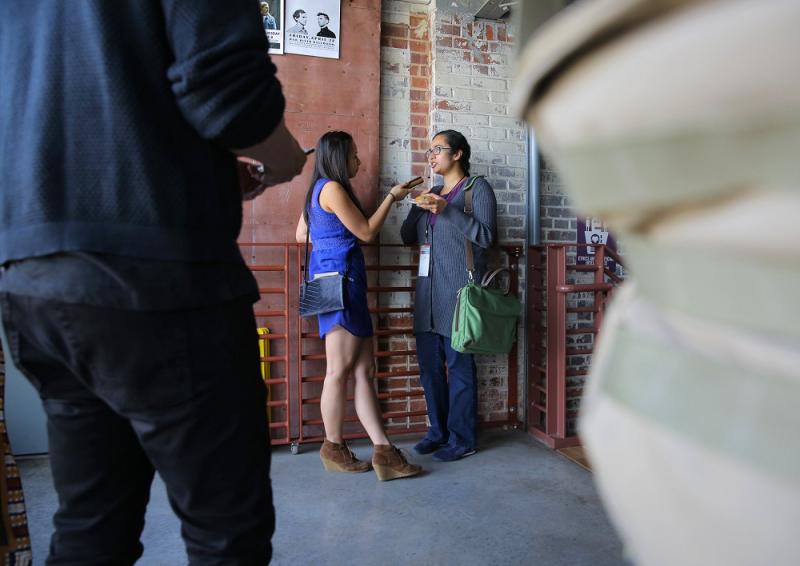Where We Work
See our interactive map


SwitchPoint is fertile ground for sparking collaborations between dreamers and thinkers of many disciplines. Photo courtesy of IntraHealth International.
Connections are the impetus for SwitchPoint.
Does your professional universe provide spaces where you can connect with other people? Like, let’s-start-a-side-hustle-together kind of connections?
My workshop at the 2019 Create Good Conference focused on fostering real connections like these. Being a presenter was a change for me—usually I’m on the other side of the curtain, frantically trying to ensure smooth sailing at IntraHealth International’s signature conference, SwitchPoint. Being a presenter instead of an organizer was my chance to make some new connections while sharing with others what I’ve learned over the past eight years producing SwitchPoint.
IntraHealth hosts SwitchPoint because we have a firm belief that unexpected partnerships have great potential to advance health and social good. And we’ve seen examples of this firsthand (more on that later). IntraHealth also believes that it’s important to hear personal accounts from health workers, humanitarian innovators, and program implementers who are on the ground, doing the work and providing the health care we want to expand universally. SwitchPoint provides a picture-perfect platform to hear their testimony. And SwitchPoint is an opportunity for IntraHealth to showcase our commitment to collaboration.
So that’s the why, but what about the how? Follow me behind the curtain.
Connections are the impetus for SwitchPoint. We want people from different fields talking to each other, coming up with ideas for how they can work together. So we design the conference structure to do just that.
It starts with what we call the Innovator’s Forum. This is a private gathering for conference speakers in an intimate setting, offstage, out of the limelight. We’ve found that getting this group together for a day of collaboration before the two public days of the conference makes the whole event more comfortable, unified, and effective.
We want people from different fields talking to each other, coming up with ideas for how they can work together.
Each year the Innovator’s Forum centers around a theme; this year it was tenacity. In small groups, presenters shared examples of how they showed tenacity in the face of personal adversity and examples of other people’s tenacity that moved them deeply. This was a quick and powerful way to get to know the other speakers, and learn what drives them.
During the following two days of presentations, microlabs—our version of breakout sessions—offer a chance for participants to stretch their legs and minds. Microlabs mirror the founding principal of the conference: when two seemingly different things come together, unexpected partnerships form and unusual solutions emerge. We pair microlab presenters very intentionally to ensure a dynamic discussion and/or activity, but also with the hope that a tangible project or collaboration will result.
In a memorable 2017 microlab, we paired wedding dress designer/Ebola suit redesigner Jill Andrews with research health informaticist Robert Furberg in a “Wearables” microlab. The resulting ideas for innovative ways to use wearables were incredible – not only for health-related issues (insoles that can detect heart disease) but also for economic innovations (scan your hand to pay for coffee or medicine).
In 2019, another microlab asked: What is the sound of data? Can data create music that prods action? The “Sound, Data, and Humanity” microlab combined journalist and filmmaker Leah Borromeo, artistic director Hope Azeda, and poet CJ Suitt and used climate change data as fodder for creative endeavors (think: symphony, performances, and poetry advocating for regulations to save the planet). The sounds that came out of this mircolab continue to resonate with attendees as they work toward climate justice.
Speaking of creative endeavors, SwitchPoint is known for incorporating visual and performing art throughout the conference. But this isn’t just for show. Art can reinforce messages, reset minds, shift perspectives, make the impossible possible. It is a tool everyone can use to advocate for change. The very act of creating can be powerful and empowering. Pairing art and activism—artivism—also aids in fostering connections at SwitchPoint.
The creators of Beat Making Lab, Pierce Freelon and Steven Levitin, presented at one of the very first SwitchPoints about their work using music to engage youth. This idea of mixing art, youth, and activism was the inspiration behind a project IntraHealth led to engage youth in Ethiopia to use music to discuss important and often stigmatized topics such as sex, contraceptive use, and family planning.
Another unusual partnership aided by artivism included poet Will McInerney and president of Syrian American Medical Society, Zaher Sahloul. The two met for the first time at SwitchPoint 2015 and by the following April had already started a partnership that combined storytelling and poetry with facts and figures to advocate for Syrian refugees. In Will’s words, “Stories are they key to unlocking human potential. Stories can change the way we think, the way we speak, and thus, the way we act.”
In a world where it’s easy to feel helpless and isolated, art can encourage action and connection. As the German poet and playwright Bertolt Brecht famously said, “Art is not a mirror held up to reality but a hammer with which to shape it.”
Our hope is that SwitchPoint has and will continue to shape connections that help improve the health of our planet and all who reside on it.
IntraHealth’s annual SwitchPoint conference is where humanitarian innovation, global health, and technology collide. Did you make a connection at SwitchPoint or know of one we should feature? Tell us about it!
Get the latest updates from the blog and eNews




